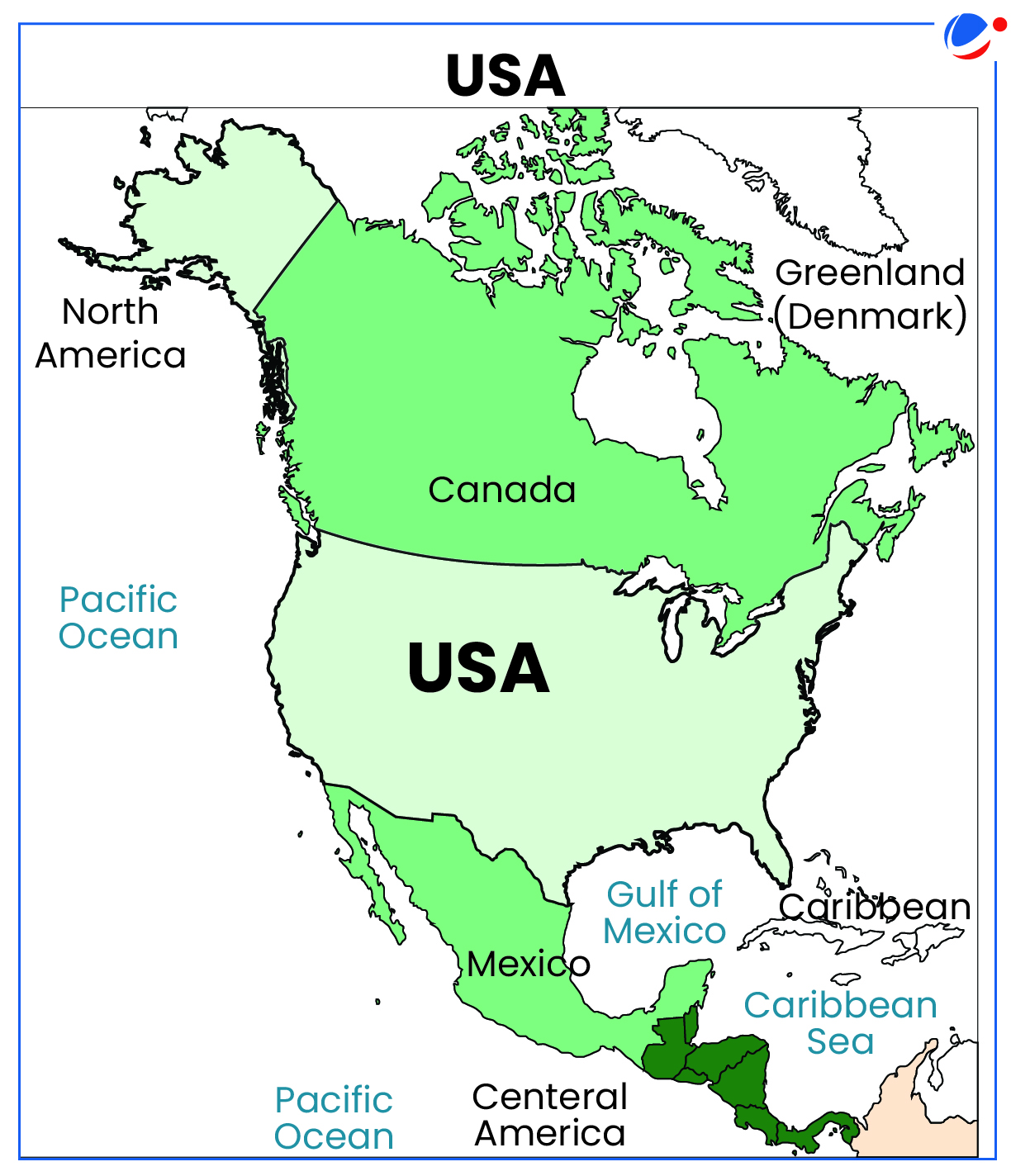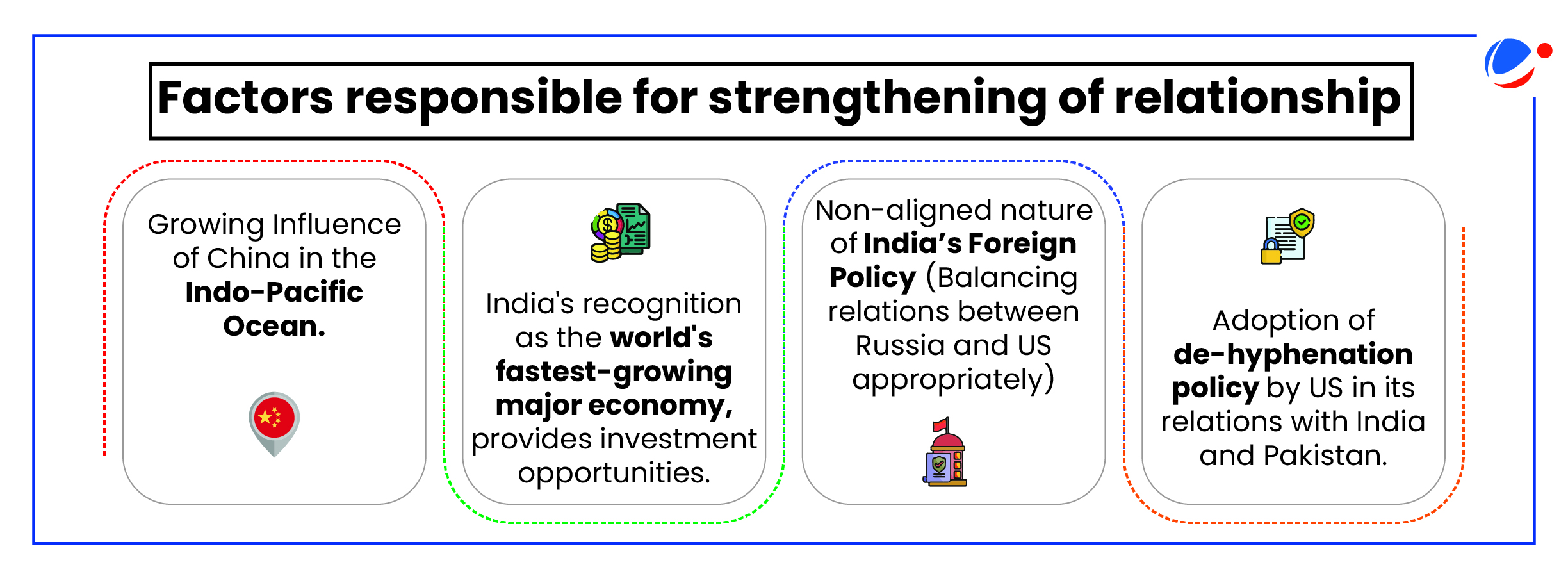Why in the News?
The Indian Prime Minister paid an Official Working Visit to the USA.
Key Outcome of the Visit
Area/Sphere | Development |
Defense & Security |
|
Technology and Innovation |
|
Others |
|

Significance of a Robust India-US Relationship
- Advancing Economic Opportunities: USA is the top-most merchandise export destination for India.
- India has joined three pillars of USA led Indo-Pacific Economic Framework [IPEF].
- Strengthening Global Strategic Influence: E.g. Quad, a diplomatic partnership between Australia, India, Japan, and the United States committed to supporting an open, stable and prosperous Indo-Pacific.
- Such initiatives will help in countering the influence of China.
- Defense Modernization and Capacity Development: India has signed foundational defense agreements with US which include a General Security Of Military Information Agreement (GSOMIA), Logistics Exchange Memorandum of Agreement (LEMOA), Communications Compatibility and Security Agreement (COMCASA) and Basic Exchange and Cooperation Agreement (BECA).
- US recognized India as a Major Defense Partner with Strategic Trade Authorization-1 (STA‑1) authorization.
- Expanding Frontiers in Emerging Technologies: Launched US-India Initiative on Critical & Emerging Technologies (iCET, 2023).
- Expanding Space Outreach: E.g. NISAR (NASA-ISRO Synthetic Aperture Radar) mission.
- Also, India has joined the US led Artemis Accord, provides a common set of principles to enhance the governance of the civil exploration and use of outer space.
- Ensuring Energy Security: U.S.-designed nuclear reactors will be built in India to fully realize the U.S.-India 123 Civil Nuclear Agreement, 2008.
- In recent years, the U.S. has emerged as one of the largest suppliers of Liquefied natural gas (LNG) to India.
- Countering Terrorism: U.S. recently approved the extradition to India of Tahawwur Rana, accused in the 26/11 attacks.
- Support at Multilateral Forums: E.g. US support for India's permanent UN Security Council membership and Nuclear Suppliers Group.
- Supports India's bid to join the International Energy Agency as a full member.
- Fighting Climate Change & Renewable Energy: US joined the India led International Solar Alliance.
- Also, launched US-India Renewable Energy Technology Action Platform (RETAP).
- Both are part of Global Biofuels Alliance (GBA)

Issues Straining India-US Partnership in recent times
- Trade & Economic Challenges
- Imposition of reciprocal tariffs along with other protectionist measure will make Indian products less competitive.
- India remained on the Priority Watch List of the U.S. 2024 "Special 301" report, an annual review of the global state of intellectual property rights (IPR) protection and enforcement.
- US revoked India's GSP (Generalized System of Preferences) in 2019, impacting duty-free Indian exports.
- Geopolitical Divergences: India follows strategic autonomy and independent foreign policy.
- E.g. India is part of QUAD but avoids turning it into a military alliance and India's stance on Russia-Ukraine War
- Visa & Immigration Challenges: Recently, US is tightening visa regulations (E.g. H-1B Visa), which will affect Indian IT professionals and others.
- Also, illegal Indian Immigrants have been deported.
- Concerns over Human & Religious Rights: Concerns raised by the United States Commission on International Religious Freedom (USCIRF) against the Citizenship (Amendment) Act (CAA), 2019 have been seen as internal interference in India.
- Imposition of Sanctions: US has raised concerns over the acquisition of advanced weaponry, such as the S-400 air defense system from Russia by India, citing potential implications under the Countering America's Adversaries through Sanctions Act (CAATSA).
Ways to further Strengthen India-US Partnership
- Finalizing Bilateral Trade Agreement (BTA): A BTA would enhance market access, reduce tariffs, boost investment, strengthen supply chains, etc.
- Also, it will help in resolving issue related with reciprocal tariff, IPR, etc.
- Finalisation of defence framework: Both countries can work for early finalization of new 10-year defence framework that will run from 2025 to 2035
- Reciprocal Defense Procurement (RDP) agreement can also be finalised.
- Easing H-1B Visa Restrictions: The US can streamline visa processes for Indian IT professionals, researchers, etc.
- Waiver under CAATSA: Influence of Indian-American can be used to get long-term exemptions for India under CAATSA to strengthen defense ties and counter regional threats.
- Managing Concerns over Human & Religious Rights: The US should avoid interference in India's internal affairs, recognizing the diversity of its democratic system.
- Enhance cooperation in emerging technologies and artificial intelligence (AI): It is essential as data regulation, information sharing, and privacy protection is crucial to national security.
- E.g. U.S.-India Roadmap on Accelerating AI Infrastructure will be prepared under U.S.-India TRUST Initiative.



